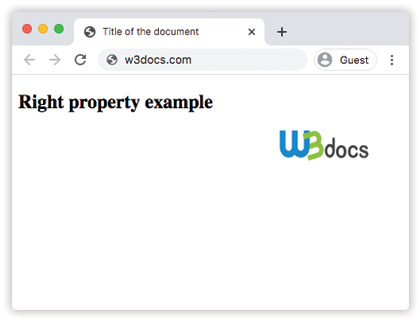The right property specifies part of the position of positioned elements.
The right property is used to set the right margin edge of the element and the right edge of its containing block for absolute or fixed positioned elements.
If position is selected "static", the right property won't have any effect.
The effect of right depends on how the element is positioned (see position property).
- If position is set to "absolute" or "fixed", the right property specifies the distance between the element's edge and the right edge of its containing block.
- If position is set to "relative", the right property specifies the distance the element's right edge is moved to the right from its normal position.
- If position is set to "sticky", the right property changes its position to relative when the element is inside the viewport, and changes to fixed when it is outside.
- If position is set to "static", there won't be any effect.
| Initial Value | auto |
| Applies to | Positioned elements. |
| Inherited | No. |
| Animatable | Yes. Position of the element is animatable. |
| Version | CSS2 |
| DOM Syntax | Object.style.right = "50px"; |
Syntax
right: auto | length | initial | inherit;Example of the right property:
<!DOCTYPE html>
<html>
<head>
<title>Title of the document</title>
<style>
img {
position: absolute;
right: 35px;
}
</style>
</head>
<body>
<h2>Right property example</h2>
<img src="/build/images/w3docs-logo-black.png" alt="W3docs logo" width="146" height="41">
</body>
</html>Result

Example of the right property specified in "%":
<!DOCTYPE html>
<html>
<head>
<title>Title of the document</title>
<style>
div {
height: 150px;
width: 100%;
background-color: #ccc;
color: #ffffff;
}
img {
position: absolute;
right: 30%;
top: 120px;
}
</style>
</head>
<body>
<h2>Right property example</h2>
<img src="/build/images/w3docs-logo-black.png" alt="W3docs logo" width="146" height="41">
<div>This is some div element.</div>
</body>
</html>Example of the right property with the "initial" value:
<!DOCTYPE html>
<html>
<head>
<title>Title of the document</title>
<style>
div {
position: relative;
max-width: 300px;
line-height: 20px;
}
p {
position: absolute;
right: initial;
background-color: lightgreen;
}
</style>
</head>
<body>
<h2>Right property example</h2>
<div>
Lorem ipsum, or lipsum as it is sometimes known, is dummy text used in laying out print, graphic or web designs
<p>Some text</p>
</div>
</body>
</html>Values
| Value | Description | Play it |
|---|---|---|
| auto | Sets the right edge position. It is the default value of this property. | Play it » |
| length | Sets the right edge position with px, cm etc. Negative values are allowed. | Play it » |
| % | Sets the right edge position with % of containing element. Negative values are allowed. | Play it » |
| initial | It makes the property use its default value. | Play it » |
| inherit | It inherits the property from its parents element. |
Browser support
|
|
|
|
|
|
|---|---|---|---|---|
| 1.0+ | 12.0+ | 1.0+ | 1.0+ | 5.0+ |
Practice Your Knowledge
What is the role of the 'right' property in CSS?
Correct!
Incorrect!
Quiz Time: Test Your Skills!
Ready to challenge what you've learned? Dive into our interactive quizzes for a deeper understanding and a fun way to reinforce your knowledge.